🎗️Lonny's War Update- October 735, 2023 - October 10, 2025 🎗️
🎗️Day 735 that 48 of our hostages are still in Hamas captivity🎗️
Hamas will not hold ceremonies when handing over hostages, sources say
Hamas has agreed during talks in Egypt that it will not hold ceremonies during the handover of hostages to Israel, an Arab diplomat and a second source familiar tell The Times of Israel.
The ceremonies during the previous hostage deal at the beginning of the year, which saw emaciated hostages paraded before a crowd alongside anti-Israel slogans, infuriated both Israel and the US.
Hamas spokesperson says all bodies may be released at same time as living hostages
Hamas spokesperson Hazem Qassem tells Al Jazeera that all living and deceased hostages could be released at the same time if conditions on the ground allow it, without specifying what those conditions may be.
Qassem adds that Hamas has informed the mediators of the difficulties related to handing over the bodies of hostages, citing the extensive destruction in Gaza during the war.
During the interview, Qassem does not verify if a commitment to release all hostages within 72 hours also includes the transfer of bodies of hostages who were killed
Israel and talks mediators to search jointly for hostages’ bodies in Gaza — Turkey
A joint task force made up of Israel, the United States, Qatar, Turkey and Egypt will be established to locate the bodies of deceased hostages in Gaza whose locations are unknown, a senior Turkish official says.
Turkish officials took part in negotiations in Egypt that resulted in a ceasefire and hostage deal earlier on Thursday, joining the US, Egypt and Qatar as mediators.
- Singing, cheering, anticipation mix at Hostages Square after deal to free captives
Tel Aviv plaza, long the hub of hostage rallies, sees singing, dancing, praise for Donald Trump, and continued wariness hours after agreement announcedJust weeks after the massacre of October 7, 2023, Dana Felz-Russo came to what was becoming known as Hostages Square, in central Tel Aviv, with a table and a box of 200 T-shirts a friend had printed — aiming to raise awareness for the 251 hostages who had recently been kidnapped to Gaza.
On Thursday morning, nearly two years later, Felz-Russo stood cheering and hugging with seven other women under a broad tent displaying a dizzying array of merchandise: T-shirts in Hebrew and English, pins, hats, jewelry, posters, tote bags and more. Yellow umbrellas reading “Now!” were sold out amid intermittent rain.
Since she first began selling the apparel — with proceeds going to support advocacy efforts for the hostages — she’s built a squad of 110 volunteers who staff several points of sale 12 hours a day, seven days a week.
They call themselves the “Shirt Team.” And they hope that soon, their work will be done. Like thousands of others coming to Hostages Square on Thursday morning, they were celebrating the announcement of a deal just hours earlier to bring home the 48 captives still held by terror groups in Gaza — the people who have been the focus of their efforts for many long months.
“I hope we can close up and go home,” she said to applause from a small crowd of onlookers. Afterward, in an interview, she added that if and when the hostages come back, “I think we’ll change the symbols to, ‘We returned them, and now we’re living.'”
That mix of cautious optimism and euphoria pervaded Hostages Square on Thursday, as relatives of hostages and their supporters filled the plaza both to celebrate and anticipate the deal. It was announced in the early hours of the morning on Thursday and was due to be ratified by the government in the evening. The hostages — some 20 living, at least 26 thought to be dead — are meant to come home within the subsequent 72 hours.
 Dana Felz-Russo, left, and other volunteers selling merchandise at Tel Aviv’s Hostages Square celebrate an agreement to bring back the 48 remaining captives on October 9, 2025 (Ben Sales/Times of Israel)
Dana Felz-Russo, left, and other volunteers selling merchandise at Tel Aviv’s Hostages Square celebrate an agreement to bring back the 48 remaining captives on October 9, 2025 (Ben Sales/Times of Israel)At the square, a giant clock continued to count the 733-plus days during which the hostages have been in captivity. An image of an hourglass stood with the sand collected at the bottom. But in the crowd, there was a feeling that a difficult era was ending, and that the return so many had hoped for was finally at hand.
“There have been so many moments of longing and suffering here,” said Misha Nataf, who came to Hostages Square from Haifa along with his wife Yaara and their 10-month-old son, Ilan. Nataf said that, aside from the period surrounding his baby’s birth, he’s traveled down from Haifa to the square every week.
“We came here as a corrective, in order to really celebrate with everyone, and it’s really exciting,” he said. “It was important for me to be here today.”
He added: “The time for repair and redemption, and for rebuilding, has come, that we should build a better world and a better society.”
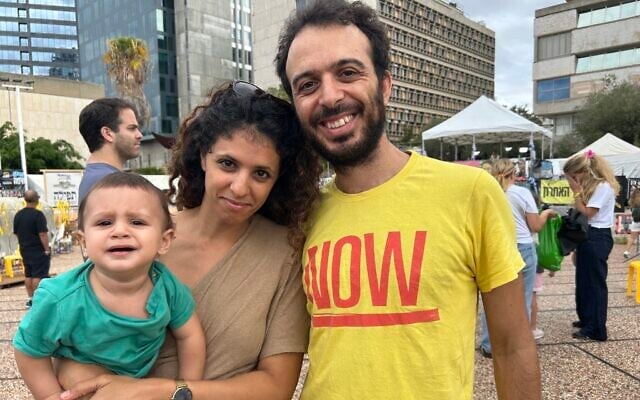 Yaara, Misha and baby Ilan Nataf at Hostages Square in Tel Aviv on October 9, 2025. (Ben Sales/Times of Israel)
Yaara, Misha and baby Ilan Nataf at Hostages Square in Tel Aviv on October 9, 2025. (Ben Sales/Times of Israel)Tamar Hertanu, who came from the suburb of Kiryat Ono with her three grandchildren, also said it felt like a moment to show up.
“The younger generation also needs to know about the difficult thing we’ve gone through, that we’re at the end of now,” she said. “We talk about it with them already in language they understand: the difficult thing that the people of Israel went through, and our revival.”
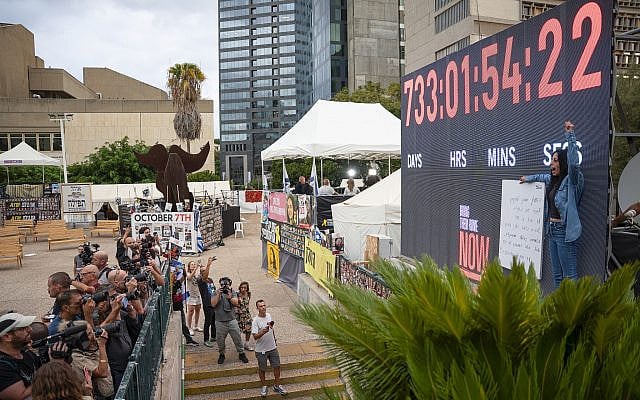 Einav Zangauker, mother of hostage Matan Zangauker, reacts to a hostage deal at Hostages Square in Tel Aviv on October 9, 2025. (Maya Levin / AFP)
Einav Zangauker, mother of hostage Matan Zangauker, reacts to a hostage deal at Hostages Square in Tel Aviv on October 9, 2025. (Maya Levin / AFP)Another weekly rally attendee, Rachel Shani Stopper, said she came from work, and found herself doing something she hadn’t done there before — belting out songs and dancing with friends.
Shortly after a downpour sent the crowd scrambling under awnings and tents, Shani Stopper and a few others were in the middle of the plaza leading a group in Israel and Jewish standards — from “Hava Nagila” to “L’shana Haba’a,” a song projecting optimism about the year to come.
Sometimes they danced in place. At other moments, they joined in a classic Israeli folk dancing circle, the dancers joining together at intervals.
“For two years we’ve held the sadness, pain and frustration, and now it’s just coming out, you can’t control it,” she said. “Yes, we’re waiting to see them here, but the happiness that it’s signed that there’s an agreement, that brings it all out.”
Avi Loenstein, who came with his wife Ofra Zion, also skipped work to come to the square.
“I’m here every Saturday night,” he said.”This is the first time I’m coming here with a smile.”
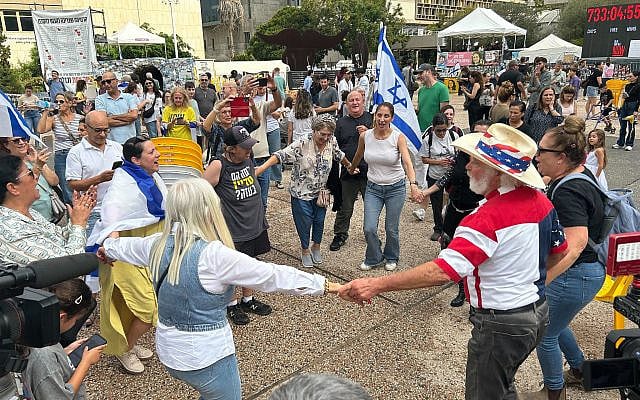 Israelis celebrate the announcement of a deal to free all hostages, end the war in Gaza at Hostages Square in Tel Aviv on October 9, 2025 (Ben Sales/Times of Israel)
Israelis celebrate the announcement of a deal to free all hostages, end the war in Gaza at Hostages Square in Tel Aviv on October 9, 2025 (Ben Sales/Times of Israel)Others were more hesitant, waiting for the hostages to come home before rejoicing.
“We’ll hope for the best,” said Alon Shirizly, a frequent attendee at rallies to free the hostages who was sporting a multicolored Tembel hat and a red shirt that said, “Without them, home is gone.”
“We’re only at the beginning of a very long road,” he said. “For the moment, there’s euphoria, but we need to remember that we need to bring back 20 living hostages, and another 28 fallen who may not be found.”
After the hostages return, he said, he plans to take a break. “The time has come to rest after two years in the streets,” he said, adding, “First of all, I want to see everyone here.”
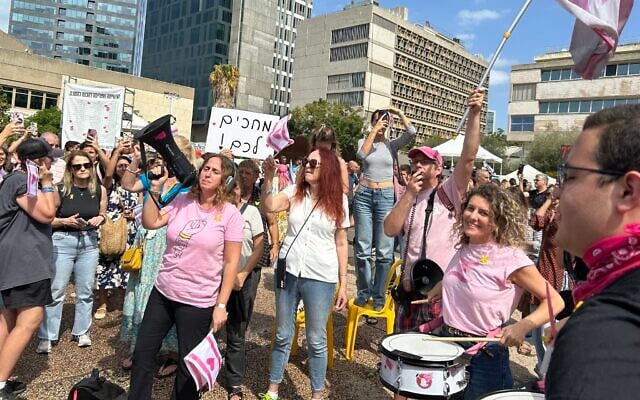 Rallygoers in Tel Aviv’s Hostages Square on October 9, 2025. (Ben Sales/Times of Israel)
Rallygoers in Tel Aviv’s Hostages Square on October 9, 2025. (Ben Sales/Times of Israel)Rotem Cooper, son of slain hostage Amiram Cooper, said at the square that he had “distorted” feelings, but is hoping for a measure of “closure” following the announcement of the deal.
“You don’t make any preparations, you take it one day at a time,” he told reporters. “We want to get some closure. We’re not trying to forget… but we want some small closure and to focus more on building.”
His father, according to the IDF, was murdered in captivity after being taken hostage. Rotem’s mother, Nurit, was also taken captive but released weeks after the attack in a humanitarian gesture.
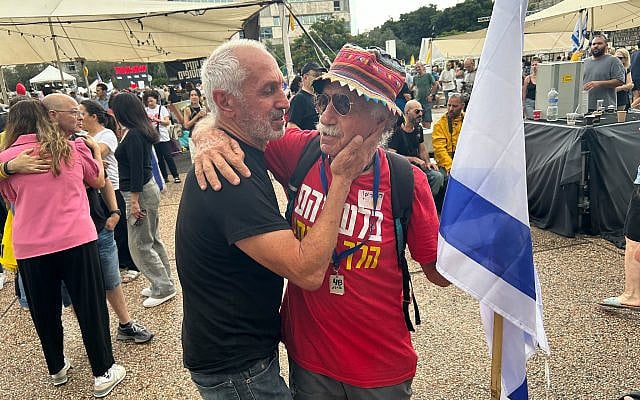 Alon Shirizly (right) and a friend celebrate news that Israel and Hamas reached a hostage deal in Gaza, Tel Aviv’s Hostages Square, October 9, 2025. (Ben Sales/Times of Israel)
Alon Shirizly (right) and a friend celebrate news that Israel and Hamas reached a hostage deal in Gaza, Tel Aviv’s Hostages Square, October 9, 2025. (Ben Sales/Times of Israel)Israel expects that a number of the slain hostages’ bodies may not be found or returned. Rotem said he is focusing on supporting the living hostages to be released, including those from Nir Oz, which his father co-founded.
“My only preparations are to cancel everything on my calendar and to be here for the families, first of all for the living hostages,” he said. “First thing, let’s receive them.”
If the terror group does not return his father’s body, he said, “It’s too horrible to think about.”
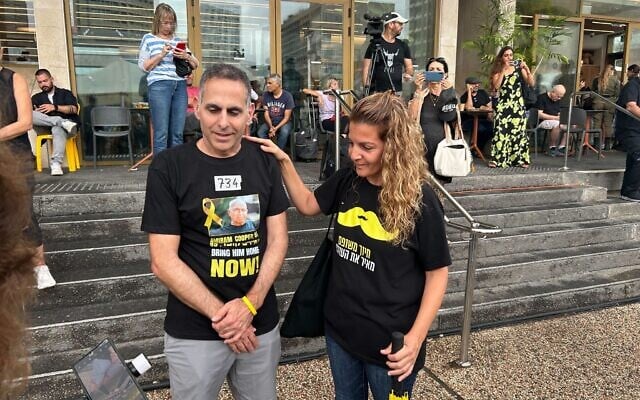 Rotem Cooper, son of murdered hostage Amiram, speaks at Hostages Square on October 9, 2025; (Ben Sales/Times of Israel)
Rotem Cooper, son of murdered hostage Amiram, speaks at Hostages Square on October 9, 2025; (Ben Sales/Times of Israel)He also had harsh words for Prime Minister Benjamin Netanyahu.
Just weeks after the massacre of October 7, 2023, Dana Felz-Russo came to what was becoming known as Hostages Square, in central Tel Aviv, with a table and a box of 200 T-shirts a friend had printed — aiming to raise awareness for the 251 hostages who had recently been kidnapped to Gaza.On Thursday morning, nearly two years later, Felz-Russo stood cheering and hugging with seven other women under a broad tent displaying a dizzying array of merchandise: T-shirts in Hebrew and English, pins, hats, jewelry, posters, tote bags and more. Yellow umbrellas reading “Now!” were sold out amid intermittent rain.
Since she first began selling the apparel — with proceeds going to support advocacy efforts for the hostages — she’s built a squad of 110 volunteers who staff several points of sale 12 hours a day, seven days a week.
“I hope we can close up and go home,” she said to applause from a small crowd of onlookers. Afterward, in an interview, she added that if and when the hostages come back, “I think we’ll change the symbols to, ‘We returned them, and now we’re living.'”
That mix of cautious optimism and euphoria pervaded Hostages Square on Thursday, as relatives of hostages and their supporters filled the plaza both to celebrate and anticipate the deal. It was announced in the early hours of the morning on Thursday and was due to be ratified by the government in the evening. The hostages — some 20 living, at least 26 thought to be dead — are meant to come home within the subsequent 72 hours.
 Dana Felz-Russo, left, and other volunteers selling merchandise at Tel Aviv’s Hostages Square celebrate an agreement to bring back the 48 remaining captives on October 9, 2025 (Ben Sales/Times of Israel)
Dana Felz-Russo, left, and other volunteers selling merchandise at Tel Aviv’s Hostages Square celebrate an agreement to bring back the 48 remaining captives on October 9, 2025 (Ben Sales/Times of Israel)At the square, a giant clock continued to count the 733-plus days during which the hostages have been in captivity. An image of an hourglass stood with the sand collected at the bottom. But in the crowd, there was a feeling that a difficult era was ending, and that the return so many had hoped for was finally at hand.
“There have been so many moments of longing and suffering here,” said Misha Nataf, who came to Hostages Square from Haifa along with his wife Yaara and their 10-month-old son, Ilan. Nataf said that, aside from the period surrounding his baby’s birth, he’s traveled down from Haifa to the square every week.
“We came here as a corrective, in order to really celebrate with everyone, and it’s really exciting,” he said. “It was important for me to be here today.”He added: “The time for repair and redemption, and for rebuilding, has come, that we should build a better world and a better society.”
 Yaara, Misha and baby Ilan Nataf at Hostages Square in Tel Aviv on October 9, 2025. (Ben Sales/Times of Israel)
Yaara, Misha and baby Ilan Nataf at Hostages Square in Tel Aviv on October 9, 2025. (Ben Sales/Times of Israel)Tamar Hertanu, who came from the suburb of Kiryat Ono with her three grandchildren, also said it felt like a moment to show up.
“The younger generation also needs to know about the difficult thing we’ve gone through, that we’re at the end of now,” she said. “We talk about it with them already in language they understand: the difficult thing that the people of Israel went through, and our revival.”
 Einav Zangauker, mother of hostage Matan Zangauker, reacts to a hostage deal at Hostages Square in Tel Aviv on October 9, 2025. (Maya Levin / AFP)
Einav Zangauker, mother of hostage Matan Zangauker, reacts to a hostage deal at Hostages Square in Tel Aviv on October 9, 2025. (Maya Levin / AFP)Another weekly rally attendee, Rachel Shani Stopper, said she came from work, and found herself doing something she hadn’t done there before — belting out songs and dancing with friends.
Shortly after a downpour sent the crowd scrambling under awnings and tents, Shani Stopper and a few others were in the middle of the plaza leading a group in Israel and Jewish standards — from “Hava Nagila” to “L’shana Haba’a,” a song projecting optimism about the year to come.
Sometimes they danced in place. At other moments, they joined in a classic Israeli folk dancing circle, the dancers joining together at intervals.
“For two years we’ve held the sadness, pain and frustration, and now it’s just coming out, you can’t control it,” she said. “Yes, we’re waiting to see them here, but the happiness that it’s signed that there’s an agreement, that brings it all out.”
Avi Loenstein, who came with his wife Ofra Zion, also skipped work to come to the square.
“I’m here every Saturday night,” he said.”This is the first time I’m coming here with a smile.”
 Israelis celebrate the announcement of a deal to free all hostages, end the war in Gaza at Hostages Square in Tel Aviv on October 9, 2025 (Ben Sales/Times of Israel)
Israelis celebrate the announcement of a deal to free all hostages, end the war in Gaza at Hostages Square in Tel Aviv on October 9, 2025 (Ben Sales/Times of Israel)Others were more hesitant, waiting for the hostages to come home before rejoicing.
“We’ll hope for the best,” said Alon Shirizly, a frequent attendee at rallies to free the hostages who was sporting a multicolored Tembel hat and a red shirt that said, “Without them, home is gone.”
“We’re only at the beginning of a very long road,” he said. “For the moment, there’s euphoria, but we need to remember that we need to bring back 20 living hostages, and another 28 fallen who may not be found.”
After the hostages return, he said, he plans to take a break. “The time has come to rest after two years in the streets,” he said, adding, “First of all, I want to see everyone here.”
 Rallygoers in Tel Aviv’s Hostages Square on October 9, 2025. (Ben Sales/Times of Israel)
Rallygoers in Tel Aviv’s Hostages Square on October 9, 2025. (Ben Sales/Times of Israel)Rotem Cooper, son of slain hostage Amiram Cooper, said at the square that he had “distorted” feelings, but is hoping for a measure of “closure” following the announcement of the deal.
“You don’t make any preparations, you take it one day at a time,” he told reporters. “We want to get some closure. We’re not trying to forget… but we want some small closure and to focus more on building.”
His father, according to the IDF, was murdered in captivity after being taken hostage. Rotem’s mother, Nurit, was also taken captive but released weeks after the attack in a humanitarian gesture.
 Alon Shirizly (right) and a friend celebrate news that Israel and Hamas reached a hostage deal in Gaza, Tel Aviv’s Hostages Square, October 9, 2025. (Ben Sales/Times of Israel)
Alon Shirizly (right) and a friend celebrate news that Israel and Hamas reached a hostage deal in Gaza, Tel Aviv’s Hostages Square, October 9, 2025. (Ben Sales/Times of Israel)Israel expects that a number of the slain hostages’ bodies may not be found or returned. Rotem said he is focusing on supporting the living hostages to be released, including those from Nir Oz, which his father co-founded.
“My only preparations are to cancel everything on my calendar and to be here for the families, first of all for the living hostages,” he said. “First thing, let’s receive them.”
If the terror group does not return his father’s body, he said, “It’s too horrible to think about.”
 Rotem Cooper, son of murdered hostage Amiram, speaks at Hostages Square on October 9, 2025; (Ben Sales/Times of Israel)
Rotem Cooper, son of murdered hostage Amiram, speaks at Hostages Square on October 9, 2025; (Ben Sales/Times of Israel)He also had harsh words for Prime Minister Benjamin Netanyahu.
“We failed as a society, certainly the leadership,” he said. “And above all, the prime minister doesn’t get points because he’s bringing my father back in a body bag.”Of his father, Rotem said: “He’s a person who established the state, established the kibbutz. He should not have met his end like this.”
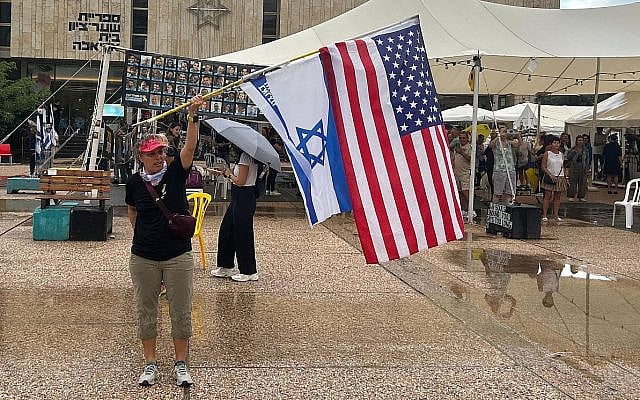 Miki Ziv waves US and Israeli flags in Tel Aviv’s Hostages Square on October 9, 2025. (Ben Sales/Times of Israel)
Miki Ziv waves US and Israeli flags in Tel Aviv’s Hostages Square on October 9, 2025. (Ben Sales/Times of Israel)The one leader to get praise from across the crowd was US President Donald Trump, whom many credited with bringing the deal to fruition. One was Miki Ziv, a protest regular who said she’d been standing in the square since 5 a.m.
Ziv was waving large Israeli and American flags while wearing a pink visor reading “TRUMP LAS VEGAS” in capital letters, a souvenir relatives brought back from the US for her. The American flag, she said, belongs to a friend traveling in Thailand who asked her to take care of it for him.
She was also critical of her own government’s handling of the crisis.
“We understood that Trump would bring back the hostages and that’s what happened, unfortunately,” she says. “We trusted our own government, but God wanted this and Trump gave it a big push for things to happen here.”
Of the US president, she added: “Whoever steps out of line a bit, they succeed, so hats off to him.”
Others showed up at the square in tribute costumes to Trump. One wore what appeared to be a paper mask of the president’s head, a loose-fitting black suit and tie, and Israeli and American flags. Another wore a red-and-white striped dress and a star-spangled blue hat, and carried a huge sign reading “We [heart] Trump.”
 A man wearing a mask of US President Donald Trump celebrates news of a hostage deal in Gaza, Tel Aviv’s Hostages Square, October 9, 2025. (Ben Sales/Times of Israel)
A man wearing a mask of US President Donald Trump celebrates news of a hostage deal in Gaza, Tel Aviv’s Hostages Square, October 9, 2025. (Ben Sales/Times of Israel)Trump has been framing the deal as a gateway to broader Middle East peace. For now, many of the attendees at the plaza were more focused on the immediate task of welcoming the hostages home, and providing a fitting burial to those who have been slain.
But some people took a moment to consider what would happen to Hostages Square once there are no more hostages.
“I would like to come back to regular life,” Tel Aviv Mayor Ron Huldai said in a brief interview. “This is it. This is a public square, and life changes.”
But Felz-Russo hopes that the square where she has spent so much of the last two years will retain a little of what it has become — and that it will also open the door to hope.
“I want there to be a memorial to October 7 here, that we’ll always remember those who fought, those who we abandoned, those we weren’t there for,” she said. “And those who returned, that we’ll be happy, and go back to living.” link
- Dead hostages’ families worry about condition in which they will be returned, if at all
Relatives of those who were killed and taken captive, or who died in captivity, rejoice with families of living hostages, but acknowledge deal brings different hopes and fears
Michel Illouz, father of slain captive Guy Illouz, hugs Einav Zangauker, mother of hostage Matan Zangauker, at Tel Aviv's Hostages Square early on Thursday, October 9, 2025 (Channel 12 screengrab)As hostage family members gathered in Tel Aviv’s Hostages Square at 3:30 a.m. Thursday to celebrate President Donald Trump’s announcement of a deal to imminently free their loved ones from Hamas captivity, Anat Angrest, mother of hostage Matan Angrest, turned to Einav Zangauker, mother of hostage Matan Zangauker, and said, a smile on her face, “Our Matans are coming back!”
The two women embraced in scenes screened on several Israeli TV channels.
“Matan and Matan are on their way home,” said Zangauker, a familiar face in the long struggle to bring her son and the other hostages home.
Her arm was wrapped around Michel Illouz, father of Guy Illouz, who was taken hostage from the Nova desert rave and killed in captivity, and who has stood with Zangauker and the Angrests throughout two years of protests and rallies.
“We’re putting the living first,” said Illouz, “We’ll rejoice with our hostages’ families. And then, after that, when they return the corpses, we’ll mourn our personal losses.”
“We think they will all be coming back on Monday… and that will include the bodies of the dead,” he added.
Michel Illouz, father of slain hostage Guy Illouz, at a press conference in Tel Aviv on November 24, 2024. (Avshalom Sassoni/Flash90)“We will all be with Michel to close the circle,” said Hagai Angrest, the father of Matan Angrest.
Trump wrote on Truth Social on Wednesday night that the 48 hostages still held captive in Gaza would “probably be released on Monday,” including “the bodies of the dead.” Hamas has said it will likely not be able to locate all the dead hostages, and there are reports that a joint task force will be established to search for those who are not quickly returned.
Terror groups in the Gaza Strip are holding 48 hostages, including 47 of the 251 abducted by Hamas-led terrorists on October 7, 2023. They include the bodies of at least 26 confirmed dead by the IDF. Twenty are believed to be alive and there are grave concerns for the well-being of the two others, Israeli officials have said. Among the bodies held by Hamas is an IDF soldier, Hadar Goldin, killed in Gaza in 2014.
At Hostages Square on Thursday morning, as hostages’ families and their supporters danced and decorated themselves in red, white, and blue to celebrate the US-brokered deal, those whose loved ones will be brought home in coffins — or perhaps won’t be returned at all, at least in the near future — acknowledged their hopes and fears.
“Today my dream is that they will find Tamir whole,” said Yael Adar, the mother of Tamir Adar, a member of the Kibbutz Nir Oz emergency response team who was killed as he battled Hamas terrorists on October 7, his body taken hostage to Gaza.
Yael Adar, whose son Tamir Adar is held hostage in Gaza, speaks at a press conference on December 4, 2023 (Tomer Neuberg/Flash90)Adar, along with Ruby Chen, the father of abducted soldier Itay Chen, and other family members, have been endlessly vocal over the last two years about the need to bring the bodies of their loved ones home for proper burial.
“In the end, I will stand before a coffin,” said Adar, speaking to Ynet. “The living hostages who come back — their lives will be full of meaning. We are falling into the abyss of emptiness. I imagine the day after, and there is no awareness of what we will have to go through.”
Adar described a sense of isolation for herself and others in her situation, the lack of a place in the public conversation.
Ruby Chen, Father of slain Israeli hostage Itay Chen attends a protest calling for the release of hostages held by Hamas terrorists in the Gaza Strip, outside the US Embassy Branch Office in Tel Aviv, July 4, 2025. (Avshalom Sassoni/Flash90)Ruby Chen, the father of Itay Chen, a tank soldier who was considered a living hostage until March 2024, when the IDF announced that it had determined that he was killed on October 7 and abducted from the Gaza border, has previously told The Times of Israel that their family entered a “living hell,” one they have never left.
He told Ynet on Wednesday that Israel has failed as a society before, when there were fallen hostages in Gaza, including Hadar Goldin, an officer whose body was taken captive in 2014, and has been held for eleven years.
“I’m realistic — there will be those who won’t come back,” said Chen. “Will we let their families face it alone? I hope that if we face a situation where not everyone returns, we will feel the same mutual responsibility.”
Leah Goldin, left, and Simcha Goldin, the parents of Israeli soldier Hadar Goldin, whose body is held by Hamas in Gaza, attend a Tel Aviv rally calling for the release of hostages on July 12, 2025. (Avshalom Sassoni/Flash90)Leah Goldin, Hadar’s mother, wrote on social media on Wednesday morning, “This war was born 11 years ago, when it was decided to leave hostages behind in Gaza. Our Hadar symbolizes determination for true victory, and until he is returned, we are still in battle. Israel has 28 fallen hostages with no solution, and we stand watch. We call on the Government of Israel to send in search teams and bring everyone home before Hamas receives anything in return.”
Back at Hostages Square, Rotem Cooper, son of slain hostage Amiram Cooper, who was 84 when taken captive, told reporters on Thursday that he has “distorted” feelings but hopes for a measure of “closure” following the announcement of the deal to return all hostages, the living and the dead.
Rotem Cooper, son of murdered hostage Amiram, speaks at Hostages Square on October 9, 0225 (Ben Sales/Times of Israel)“We want to get some closure. We’re not trying to forget… but we want some small closure and to focus more on building,” said Cooper. “You don’t make any preparations, you take it one day at a time.” link
Ceasefire draft includes release of 20 living hostages, implying 28 considered dead
A draft of the ceasefire and hostage-release agreement under review by Israel’s security cabinet includes the return of 20 living hostages and the bodies of 28 others, Channel 12 reports.
The inclusion of 28 deceased hostages implies the deaths of two hostages over whose fates Israel had previously expressed “grave concern,” but had not pronounced dead, the network notes.
In May, Israel publicly questioned whether three hostages were still alive, reportedly referring to Israeli hostage Tamir Nimrodi, Nepali hostage Bipin Joshi and Thai hostage Pinta Nattapong. Nattapong’s body was recovered from Gaza in June.
Yesterday, Joshi’s family released a video showing him shortly after his abduction on October 7, 2023, which remains the time of his last known sign of life.
The Hostages and Missing Families Forum and the office of Gal Hirsch, the Israeli government’s pointman on hostages, did not immediately respond to a request for comment on the report.
An unsourced Channel 12 report says Israel conveyed a list to Hamas of 20 living hostages it expected to see released, and that Hamas confirmed the 20 names as those of living hostages.
Report: Parties finish talks on which Palestinian prisoners will be released in deal
Qatari outlet Al-Araby reports that discussions in Sharm el-Sheikh have concluded regarding which Palestinian security prisoners will be released as part of the ceasefire and hostage-release deal in Gaza.
The matter is now pending approval by the Israeli government, which is expected to arrive in the coming hours.
Authorities to begin informing families of terror victims if the attacker is to be released under Gaza deal
Starting this morning, Israeli authorities say they will be notifying the families of terror victims that their loved ones’ killers are expected to be released as part of a hostage deal with Hamas.
In exchange for the 48 hostages, Israel will release 250 Palestinian security prisoners who are currently serving life sentences. It will also release some 1,700 Palestinians who have been detained by the military amid operations in Gaza over the course of the war, along with 360 bodies of terrorists.
Still, Israel has not yet published a full list of those set to be released in the deal.
The families of terror victims will be notified by the National Insurance Institute, while the families of fallen soldiers, police officers, and members of other security bodies will be notified by the IDF, Israel Police, or other respective security agencies.
The Defense Ministry says it is “coordinating and overseeing the activity between the various bodies.”
- Hamas leader in Gaza: 'We received guarantees—the war is completely over'Khalil al-Hayya, head of Hamas’ delegation to the cease-fire talks in Sharm el-Sheikh, declared that mediators and the US provided assurances that the war had ended; added that the deal includes a permanent cease-fire and the opening of Rafah CrossingHamas leader in Gaza Khalil al-Hayya announced Thursday night that the terror group had received international guarantees confirming the end of the war, following the agreement reached for a cease-fire and hostage release.“The world was astonished by the sacrifice, resilience, and patience of the people of Gaza,” al-Hayya said in a statement broadcast to Gazans, coinciding with the end of Israel’s security cabinet meeting in Jerusalem. The government session, originally scheduled to begin immediately afterward, was delayed until 10 p.m. Al-Hayya, who led Hamas’ delegation in the negotiations in Sharm el-Sheikh where the agreement was signed, said the organization had acted responsibly during the talks. “On the anniversary of the October 7 battle, we salute the martyrs among our leaders—Haniyeh, al-Arouri, Sinwar, and Deif,” he said, referring to the Hamas chiefs killed in Israeli strikes. “We tell the heroes of the resistance: as you were men in battle, you were also men at the negotiating table. The enemy committed massacre after massacre and repeatedly obstructed mediation efforts. Despite these ongoing violations, we continued the negotiations and made every effort to stop the war.” Al-Hayya said Hamas had “dealt responsibly with the American president’s plan” and submitted a response “that serves our people and prevents further bloodshed.” He added that the agreement marks “the end of the war and the aggression against the Palestinian people, and the start of implementing a permanent cease-fire.” “The deal includes the entry of humanitarian aid, the opening of the Rafah crossing, and the exchange of prisoners,” al-Hayya said. “We received guarantees from the mediators and from the U.S. administration, and everyone confirmed that the war has completely ended. We will continue to work with all national and Islamic forces to complete the next steps.” link
Thousands gather at Hostages Square for Sukkot prayer service
Thousands gather at Tel Aviv’s Hostages Square for services on the third intermediate day of Sukkot.
There, they chant the Hallel, a collection of Psalms recited in Jewish liturgy on major holidays to praise God for miracles and salvation, and shake palm fronds held with myrtle and willow branches, and the citron — making up the four species used during the holiday.
Men and women are seated separately for services at the square, as is customary in Orthodox Judaism.
Dani Miran, father of hostage Omri Miran, is present, alongside the cousin of slain hostage Omer Neutra. Rabbi Chaim Gantz and Rabbi Dov Singer, representing different streams of Orthodox Judaism, are present to support the hostages’ families, as well.
There is a spirit of celebration at the square, with live music accompanying the morning service, as well as a sense of intention, of praying for the remaining hostages to return home safely.
Team of 200 American troops to ‘oversee’ Israel-Hamas ceasefire in Gaza — US officials
A US military team of 200 people will be deployed in the Middle East to “oversee” the Gaza ceasefire between Israel and Hamas after a peace deal brokered by President Donald Trump, senior US officials say.
Admiral Brad Cooper, the head of the US military’s Central Command, “will initially have 200 people on the ground. His role will be to oversee, observe, make sure there are no violations,” one senior official tells reporters.
Egyptian, Qatari, Turkish and probably Emirati military officials would be embedded in the team, he says. A second official says that “no US troops are intended to go into Gaza.”
A source familiar with the matter tells The Times of Israel that the US troops will likely be stationed in Egypt where they will develop a joint control center and integrate other security forces that will work in Gaza to coordinate with Israeli forces to avoid clashes.
Israel publishes list of 250 Palestinian prisoners it will release; Islamic Jihad commander behind 3 suicide bombings to go free
Israel has published the full list of 250 Palestinian security prisoners serving life sentences slated for release as part of the hostage-ceasefire agreement.
The list, published by the Justice Ministry, comes the morning after the cabinet approved the US-backed deal, aimed at returning the remaining hostages and permanently ending the Gaza war.
Of the 250 prisoners, 15 will be freed to East Jerusalem, 100 to the West Bank and 135 are slated for deportation.
Some last-minute changes to the list were approved this morning, after negotiators agreed to swap 11 Fatah-affiliated prisoners with Hamas-affiliated ones.
Although Hamas demanded the release of the prominent Fatah figure Marwan Barghouti, in jail for planning deadly terror attacks during the Second Intifada, he is not included on the published list.
Popular Front leader Ahmad Sa’adat, as well as senior Hamas figures Ibrahim Hamed and Hassan Salameh, are also not slated for release, despite reported pressure from Hamas negotiators.
In addition to the security prisoners, another 1,700 Gazan detainees arrested after, but not involved in the Hamas-led October 7, attack, will be freed back to the Strip or exiled abroad.
The prisoners are only expected to go free after a 72-hour period in which all hostages, living and dead, are to be released.
Among those whose names appear on the list for release is Iyad Abu al-Rub, commander of Palestinian Islamic Jihad in the Jenin area of the West Bank. He is responsible for orchestrating and overseeing a number of terror attacks, including a suicide bombing in Shadmot Mechola in June 2003, a suicide bombing in Tel Aviv in February 2004 and a suicide bombing in Hadera in 2005. In total, 13 people were killed across the three attacks.
Also due to be released are Muhammad Zakarneh, a Fatah operative who planned the 2009 attack in which taxi driver Grigory Raginovich was murdered, and Muhammad Abu al-Rub, who in 2017 carried out a stabbing attack that killed Reuven Shmerling.
In addition, Mahmoud Qawasmeh, a senior Hamas member who was released in the Shalit deal, deported to Gaza, and later re-arrested during the war in Gaza in 2024, will also be released.
- Emotions run high in Israeli border communities ahead of hostage release
Israeli Gaza border communities express hope and prepare for emotional reunions after a U.S.-brokered deal promises the imminent release of hostages held by Hamas since October 7; 'After two years of pain they are coming home. Only then can we heal'Following U.S. President Donald Trump’s declaration that Israel and Hamas had signed the first phase of his cease‑fire and hostage release plan, border communities began preparing for the return of their beloved friends held hostage by Hamas.“After two years of pain, struggle and nerve‑racking waiting, our sons and daughters are coming home,” wrote Michal Uziyahu, mayor of the Eshkol Regional Council, whose 15 residents are still held by Hamas.48 hostages about to return
Uziyahu also referred to the weather, writing: “Symbolically, the first drops of rain this morning have watered our fields - and finally we allow ourselves to breathe and to hold onto hope.”Photo shared by mayor of the Eshkol Regional Council: “Symbolically, the first drops of rain this morning have watered our fields"(Photo: Mia Mekitz)She added that “the Eshkol region, which was one of the main targets of the October 7 massacre, has made preparations across all systems to receive our loved ones and to provide close support to families and local communities in these complex moments."She went on to thank everyone involved in the efforts, writing: “I thank President Trump, the prime minister and all decision makers for their commitment and invested efforts that led to this historic agreement, and our security forces for their courage and effort in achieving this goal." In the Sha’ar HaNegev regional council, residents also shared their excitement about the return of hostages, including twin hostages Gali and Ziv Berman and Omri Miran, local residents. “We never stopped believing, and for more than two years we have been waiting to hug them and to tell them how much we missed them; though we are preparing responsibly to provide emotional, community and professional support to our loved ones, their families and the communities,” said Uri Epstein, Head of the Sha'ar HaNegev Regional Council. Although the hostages’ condition remains unknown, the council has begun planning for several scenarios. “In recent days, internal planning meetings have taken place involving welfare, health, education, security and community agencies, in order to ensure continuous support. "In addition, professional teams will stand with the families from day one, offering emotional and logistical relief for any other need that would surface,” Epstein said. In addition to the regional council head, Zion Regev, director of Kibbutz Kfar Aza community, also welcomed the announcement:. “Since October 7, 2023, we’ve been waiting for this news. The community is overwhelmed with emotion and deeply concerned for the return of Gali and Ziv Berman from Hamas captivity,” he said. Regev also paid tribute to the community’s victims. “We will never forget those who were murdered, and we will forever honor the heroes who risked their lives to defend our community. Only once they return safely can we begin to focus on remembrance, rebuilding and healing," he said. Community manager at Kibbutz Be'eri, Ofer Gitai, joined the voices of hope. “We are overwhelmed with emotion, but also with constant alertness until the last hostage is brought back to Israel, including for a proper burial,” he said. Gitai emphasized the contrast between “the immense joy over the return of living hostages to their families and the profound sorrow for the loved ones whose lives were brutally cut short.” He added: “Our hearts are with the families of the dead hostages, as we wait with them to close this horrific chapter by bringing home Meni Godard, Dror Or, Sahar Baruch and Yossi Sharabi, of blessed memory." Gitai also recalled that the families of the dead hostages have repeatedly said that the return of their loved ones is a necessary condition for the healing process, “so long as the living are returned first, and no soldiers are put at risk for their retrieval.” He expressed hope that the news of the hostage's imminent return brings so some relief, saying the kibbutz was now turning toward recovery. “Even just being able to mourn together brings solace and marks a first step on the long road to healing after two difficult years," he said. Head of the Tekuma administration Aviad Friedman also responded to the agreement. “The shared prayer of an entire nation is about to materialize, and a wound that has been bleeding for over two years can finally begin to heal,” he said. He noted that the administration had been committed to the hostages’ return from day one: “Every step we took in rebuilding and development was made with their absence weighing on us; only once they’re home can true Tekuma (revival) begin." Friedman said the administration would continue to work in full coordination with local authorities and communities to “realize our shared vision for the revival of the region and the doubling of its population. The return of our brothers in captivity strengthens us all and reminds us that we are fighting for our right to live here with security and hope." In a post on his Truth Social platform overnight, President Trump wrote: "I am very proud to announce that Israel and Hamas have both signed off on the first phase of our Peace Plan. This means that ALL of the hostages will be released very soon, and Israel will withdraw their troops to an agreed-upon line as the first steps toward a strong, durable, and everlasting peace... We thank the mediators from Qatar, Egypt, and Turkey, who worked with us to make this historic and unprecedented event happen." The exact timing of the hostages’ release remains unclear. However, the release is planned to happen in a single phase. link
- After the hostages return, many details of ceasefire remain unresolved
Deep Turkish involvement, Peace Council, reconstruction of Gaza Strip - who will pay and who will benefit from it, where the Gazans will live, how we determine that Hamas is disarming, the question of the "last rifle", the Israeli withdrawal, coordination with Arab armies in the Gaza Strip, and more: these are the issues that the agreement between Israel and Hamas has not yet answered, and the problems that could arise from itThe Israeli public is naturally focusing these days on one aspect of the agreement between Israel and Hamas: the return of the hostages still held by Hamas, which is expected to take place at the very start. But in fact, after the first phase many details of the agreement remain unresolved — and it seems only a clear American guarantee that the fighting will not resume allowed the process to begin without them.First, the issue of locating hostages who were killed: Because Hamas said it does not know the whereabouts of nine of the hostages, it was agreed to form an international force of Israel, the United States, Qatar, Egypt and Turkey which, with the assistance of the Red Cross, will try to search for at all the remains. That force is supposed to check information on the ground, search under rubble, send teams, take samples, and this may take many years. This mechanism still apparently needs to be formalized, as do the consequences of its actions. In Israel there are also fears that there are people whose burial places will never be found. “Within 72 hours, Hamas will share all the information it has on deceased hostages via the information-sharing mechanism,” the agreement document states. “A mechanism for information sharing between the two sides through the mediators and the International Committee of the Red Cross (ICRC) will be established to exchange information on living hostages or killed hostages who remain, who have not been identified or returned. The mechanism will ensure that all bodies are identified and returned in full. Hamas will make its utmost effort to ensure completion of its commitments as quickly as possible.” Then there is the security issue, and a big question mark around it: How do you ensure Hamas actually relinquishes its weapons? The mediators in the deal — chiefly Qatar, Turkey and Egypt — are supposed to be the ones to make sure the terrorist organization actually does so — but Israel must be involved to ensure Hamas is not cheating. The working assumption is that the terrorist organization will of course cheat, and will not give up all its weapons. It can, for example, hand over heavy weapons and perhaps some light weapons, but certainly will not give “the last rifle, the last pistol, the last grenades, the last RPG launchers,” and so on. This issue is not in the agreement document — and may be being left for the “day after.” If Hamas is not fully disarmed, and given that it still enjoys popularity among many Palestinians, that means it will still have dramatic influence over governance in the Strip — and perhaps one day could stage a takeover again. The agreement will need to meet Israel’s security demands and ensure Hamas is removed from power mechanisms; otherwise — in that respect — it will be a failure. The control mechanism in Gaza is actually another important unknown: U.S. President Donald Trump is supposed to set up the “Peace Council” and appoint people to it, so far naming only former British prime minister Tony Blair. The president will need to appoint leaders from Muslim and Arab countries, perhaps members of the World Bank and the European Union, actors with money who can contribute to the Gaza reconstruction project. This council, headed by Blair, is supposed ultimately to take command over areas in Gaza and ensure Hamas is not present there — but this process is still in its infancy and its details have not been finalized. Destruction of Gaza City(Photo: Samuel Grandos of Planet Labs, from The New York Times) Alongside the council, there is also the pan-Arab force intended to be deployed in the Strip; there has been talk of Indonesia participating and sending troops alongside the United Arab Emirates and other states, possibly Saudi Arabia as well. This will have to be fully coordinated with Israel: how do those militaries enter and take responsibility for territory, under what rules of engagement do they operate, and how do they coordinate with the IDF so there are no exchanges of fire between the parties until the withdrawal is complete? This is an extremely sensitive event, so Trump will need to continue managing it — but it is unclear how far American commitment will go on this matter. The IDF is remaining in Gaza at this stage, but will complete the withdrawal to the perimeter depending on the agreement’s progress. The details of the initial withdrawal in return for the hostages’ release have already been agreed, and it appears the IDF will stay outside city centers, but future withdrawals are supposed to be conditional on Hamas fulfilling its part of the agreement. And because the terrorist organization agreed to the deal only in light of clear American guarantees to Qatar and Turkey that Israel will not resume fire, it is unclear what will happen if gaps emerge between the parties later. What will happen, for example, if the Arab states declare that Hamas has been disarmed but Israel does not accept that finding? Another major unresolved challenge is reconstruction of Gaza, where most buildings were almost completely destroyed: Trump talks about tens of billions of dollars to be poured into the Strip — funds that are also supposed to yield huge profits for investors, to make the project attractive. But how can it be ensured that, unlike before, the money will not go to Hamas and be used to build terror infrastructure? In Gaza there are already many explosive devices scattered and many tunnels. In addition, during reconstruction — and since the “relocation” plan has been dropped — many Gazans will have nowhere to live at all, and will continue to live in tents for a long time, because much of the Strip is uninhabitable. The continuation of this situation could become a powder keg that could explode at any moment and destroy the entire arrangement. Therefore rebuilding these areas is an especially complex international task that needs to happen quickly and will require involvement from a number of countries — some of them even hostile to Israel. The economic interests in Gaza’s reconstruction are also a major unknown: among other things, the Trump family is involved, including son-in-law Jared Kushner, as well as the Erdogan family and the rulers of the Gulf states. In the administration a “Riviera” plan for Gaza has been circulating for some time, and Finance Minister Bezalel Smotrich has claimed there are talks with Americans for Israel to receive a share, because Gaza could be a “real estate bonanza.” All this raises questions about the true aims of some of those involved in the arrangement, and whether Israel will be able to benefit economically from it in some way. Another question arising from the agreement is Israel–Turkey relations, which have fallen to a new low since 7 October after a period of rapprochement. Now Turkey will be able to bring humanitarian aid into Gaza through Israel, and there is potential for reconciliation between the sides — since Ankara would need to set up a logistics hub in Ashdod to receive goods at the port and send them to Gaza. This would give Turkey a lot of leverage and create bargaining power vis-à-vis Israel, and it will likely also lead to lifting Turkey’s trade boycott and resuming Turkish Airlines flights. A few weeks ago, Trump’s son Donald Trump Jr. met with Erdogan’s son-in-law, senior Turkish figure Berat Albayrak. The Turkish opposition alleged that in that meeting the two sealed a “deal” that would result in Turkey’s involvement in humanitarian aid and Gaza reconstruction, and in return “bring” Hamas to sign the agreement. If true, it is likely Turkey will expect compensation now. And above all, probably, stands the issue of normalization — the same process Hamas tried to thwart with the 7 October attack, and which now could resume in full force. Indonesian President Prabowo Subianto’s speech at the UN General Assembly may have been a sign of things to come, but it is still unclear at what point Trump will kickstart the Abraham Accords again. It is also unclear whether Israel will be ready to do that in an election year, and how far it will go in promises of a Palestinian state as part of a deal that might be signed, for example, with Saudi Arabia. link There are many issues that need clarification and time and others are more or less known. Locating the bodies of killed hostages is going to take a lot of time and some may never be found, but the Israeli public cannot allow the government to stop the efforts even if it takes years. Hopefully, there will be a new government in place that will have far greater compassion and understanding of the pain of the families and the people and will make greater efforts to resolve this horrible situation. The security situation in Gaza will be most dependent on the new Palestinian governing body that will be put in place instead of Hamas. If they indeed will be professional technocrats and will not give in to the great temptations in front of them of graft and corruption, and will first and foremost look out for the interests of the Gazans and rebuilding, that will also have the strongest impact on the security. Gazans suffered at the hands of Hamas, long before the war and they view this war as the second Nakba (catastrophe) and blame Hamas far more than Israel for the Nakba. They want new leadership and new directions for a better future. If they see the new governing body as acting in their interests, they will be the first to help get rid of the remnants of Hamas. They, together with the international force that will be in Gaza will be responsible for getting rid of Hamas from all areas of power and terror activity. It will be in their interests. No one wants the Israeli military to come back and destroy what is left or what will be built anew. In addition, all of the countries that will be providing the huge amount of financing for rebuilding Gaza are interested in getting rid of Hamas as well. Many of the countries that will be investing or giving money from rebuilding want their money to be well spent and for the buildings to be permanent and not temporary that will be at risk in the next war with Israel. They want this to be the last war with Israel. They will be very invested in making sure that the new government works and that Hamas doesn't rear its ugly head again. Everyone knows that Trump's position of leader of this new to be created "Peace Council" will be little more than a figurehead with veto power. Trump never gets involved with any details and details will actually be the major issue for the Peace Council. He will likely appoint others to do the dirty work and take the credit for it all. The risk is if he loses interest altogether and doesn't even care what happens with this council. Due to his probable personal involvement in the rebuilding of Gaza using his companies to reap major rewards, his interest will remain with Gaza for the foreseeabe future. The financial aspects will be managed by his closest people: his sons, Witkoff, Kushner and others who are involved in the business side of the agreement. Hundreds of billions of dollars will need to be invested in Gaza over the next 10 years. The investors, more than the donors, although many will be in both positions, will be looking to turn Gaza into the next Dubai or Abu Dhabi where the rewards will be astronomical. They will not allow anything less than this and will see Hamas as a danger to their investments and to the future of the region. Turkey to monitor Gaza deal implementation, Erdogan says
Turkey will take part in efforts to monitor the implementation of the ceasefire in Gaza agreed by Israel and Hamas, President Recep Tayyip Erdogan says.
“God willing, we as Turkey will take part in the mission force that will monitor the agreement’s implementation in the field,” he says in a speech in Ankara.
He adds that Turkey will contribute to the reconstruction of Gaza.
Israel has in the past expressed concerns over Turkish support for Hamas, the terror group that is to be disarmed and shunted from power under the deal.
Israel said to reject returning body of Hamas leader Yahya Sinwar or his brother
An Israeli source quoted by Hebrew language media says that the bodies of former Hamas leader Yahya Sinwar and his brother Mohammed Sinwar will not be returned as part of a hostage for prisoners exchange being hammered out.
Yahya Sinwar is widely considered to be the architect of the October 7 massacre. His brother briefly helmed the terror group. Both were killed by Israel. link This is a demand of Hamas and will continue to be their demand through the rest of the negotiations. It will not hold up the release of the living hostages but may play a role in the release of the hostage bodies. Hamas needs to locate all of the bodies, some of whom they may have no current idea where they are. Locating them may take more time and that can give Hamas more opportunities to demand the bodies of the Sinwar brothers.
Israel obviously does not want to release the Sinwar bodies as they are very symbolic and their return would be used for Hamas public relations efforts and claim another win for their fight against the Zionist enemy.
Holding their bodies is very important, both not to give the win to Hamas and also to possibly be used at a future date as a strong card in negotiations.Apparent Hamas operatives attempt to raid IDF post in southern Gaza, army says
Operatives appearing to belong to Hamas attempted to raid an IDF post in the southern Gaza Strip a few hours ago, after a deal was reached to end the war but before a ceasefire has officially taken effect, according to the military.
The cell of three suspected gunmen approached an army encampment in the southern Khan Younis area. According to the IDF, troops at the post initially fired warning shots at the three suspects before the attackers were killed.
No soldiers were wounded in the incident, according to the military.
The IDF is preparing to pull back forces in Gaza once the ceasefire takes effect, likely this evening, after the government officially ratifies the agreement.
Hamas takes responsibility for failed attack on IDF in south Gaza, hoped to kidnap soldier
Hamas takes responsibility for a failed attack on an IDF post on the southern outskirts of Gaza City yesterday, while claiming it attempted to kidnap a soldier.
In a statement, Hamas claims that its fighters managed to raid an Israeli army encampment and open fire on troops from close range, “causing a number of them to be killed or injured.” The terror group also says it launched RPGs at Israeli tanks in the area.
“Our fighters attempted to capture one of the enemy soldiers, but the field conditions did not allow it,” the terror group’s military wing claims.
Yesterday, the IDF said that the attempted attack was carried out by at least five Hamas gunmen who had emerged from a tunnel. An Israeli Air Force drone struck and killed three of them as they were approaching the post, according to the military. The other two fled.
The IDF said no soldiers were injured in the incident, and the operatives did not manage to breach the military post.
PA’s Mahmoud Abbas: We have begun reforms in coordination with the United States
In a rare interview with Channel 12, Palestinian Authority President Mahmoud Abbas says that the PA is coordinating with the United States on reforms it is implementing against the backdrop of a ceasefire deal in Gaza that calls on the body to implement significant changes.
He adds that the international push to recognize a Palestinian state is not meant to hurt Israel.
“We launched a reform that also includes the issue of prisoners’ salaries, which we agreed upon with the United States, in addition to reforms in education, health and the economy — some have already been implemented and others will be implemented until we reach a point where the Palestinian Authority can continue to lead the Palestinian people,” Abbas says in the interview with Arad Nir.
This is Abbas’s first interview with an Israeli media outlet in several years.
The Palestinian Authority, created as a result of the 1993 Oslo Accords, governs Palestinian population centers in the West Bank. It was ousted from Gaza by Hamas in 2007, and Prime Minister Benjamin Netanyahu has ruled out the idea of the PA returning to govern the Strip after the war. The ceasefire deal proposed by US President Donald Trump says the PA could have a role in governing Gaza after undergoing deep reforms.
Abbas adds: “We hoped and we continue to hope that we can stop the bloodshed taking place in our region — in the Gaza Strip, the West Bank and Jerusalem. We hope that peace, security and stability will prevail.”
- Reports of a series of attacks in Gaza City: '4 killed and about 40 missing'In the Gaza Strip, there were reports of a series of attacks in Gaza City and that "a residential building at the Aviation junction in the city was bombed and 73 people were killed, injured or classified as missing following the attack." Civil Defense forces in Gaza reported four deaths and about 40 missing in an Israeli bombing in the Sabra neighborhood, in southern Gaza City.
- Reports of a series of attacks in Gaza City: '4 killed and about 40 missing'In the Gaza Strip, there were reports of a series of attacks in Gaza City and that "a residential building at the Aviation junction in the city was bombed and 73 people were killed, injured or classified as missing following the attack." Civil Defense forces in Gaza reported four deaths and about 40 missing in an Israeli bombing in the Sabra neighborhood, in southern Gaza City.
Hamas calls on Gaza residents not to approach IDF troops
The Civil Defense mechanism in Gaza — the emergency and rescue service under Hamas — issues a call this morning urging residents not to go near areas where Israeli forces are stationed in the Strip.
It also instructs people not to approach the borders of the enclave until an official announcement is made about an IDF withdrawal.
“Violating this warning puts your lives at risk,” the statement reads. link For anyone who didn't know better, they would think this was a humanitarian gesture so the Gazans wouldn't get hurt. I could be wrong but I believe it is so they won't have anyone get in their way and warm the troops as they attempt more attacks before the ceasefire begins. The IDF force in Gaza have been put on extremely high alert because of the desire of Hamas to score more attacks before the end of the war. Just yesterday, they attempted to kidnap a soldier and a sniper killed another soldier, and they will continue to do so until the last second. Regarding their warnings to Gaza residents, if there are Gazans around the troops as will happen more and more in the next days as the Gazans start to return to their homes, Hamas knows that the troops will have more guards around and ready for potential attacks. Hamas wants to surprise the soldiers to kill and/or kidnap as many as they can before they have to stop.
Gazans begin moving northward via coastal road after IDF completes withdrawal
Media outlets in Gaza report that residents have begun returning to the northern Gaza Strip, following the withdrawal of IDF troops.
Footage shows that hundreds of residents who had been waiting on al-Rashid Road, along Gaza’s coast since yesterday, have begun moving northward, back to their homes, in the past few minutes. link
Partial IDF withdrawal from Gaza began overnight under cover of artillery shelling, airstrikes
Overnight and this morning, the IDF began to pull back troops in the Gaza Strip to agreed-upon deployment lines as part of the deal with Hamas to secure the release of all the hostages held by the terror group.
Some forces were completely withdrawn from Gaza, while others will remain at positions along the deployment lines.
The withdrawal took place under the cover of artillery shelling and airstrikes in some areas.
The IDF is expected to complete the pullback by tonight, within 24 hours of the Israeli government officially ratifying the agreement with Hamas.
Once complete, the IDF will remain in control of just over half of the Strip’s territory, or 53 percent — most of which is outside urban areas.
This includes a buffer zone along the entire Gaza border, including the Philadelphi Corridor — the Egypt-Gaza border area — along with Beit Hanoun and Beit Lahiya in the Strip’s far north, a ridge on the eastern outskirts of Gaza City, and large portions of Rafah and Khan Younis in southern Gaza. video
IDF completes withdrawal to new deployment lines in accordance with Gaza ceasefire termsThe ceasefire in the Gaza Strip officially began at noon as the IDF says it has withdrawn troops to the agreed-upon deployment lines as part of the deal with Hamas to secure the release of all the hostages held by the terror group.
“As of 12:00 [p.m.], IDF troops have positioned themselves on the updated deployment lines, in accordance with the outline of the ceasefire and the return of the hostages agreement,” the military says.
“IDF troops in the Southern Command are deployed in the area and will continue to operate to eliminate any immediate threat,” the military adds.
Within 72 hours, meaning by Monday at noon, Hamas is set to release the 48 hostages it is holding, beginning with the 20 believed to be alive. The terror group has, in the past, told mediators it does not know where some of the bodies of slain hostages are located, which may delay the release of the bodies.
Government approves deal to free the hostages, with most ministers voting in favor; ceasefire comes into effect
The government approves the deal for Hamas to free all 48 remaining hostages in Gaza, the Prime Minister’s Office says.
With the passage of the vote, a ceasefire now comes into effect.
The release of the hostages, in exchange for some 2,000 Palestinian security prisoners and a partial IDF withdrawal, is the first phase of US President Donald Trump’s Gaza peace plan.
Most cabinet ministers vote in favor of the deal, including Minister Ofir Sofer of Finance Minister Bezalel Smotrich’s far-right Religious Zionism party, all of whose other ministers opposed the deal. So too did all members of the ultranationalist Otzma Yehudit party.
The IDF will now withdraw to new lines inside the Gaza Strip, retaining a deployment controlling some 53 percent of the Gaza territory, after which the 72-hour window for Hamas to release all the hostages will commence.
Mid-level Israeli negotiating team staying in Egypt to negotiate second phase of Gaza deal
An Israeli negotiating team made up of mid-level professionals remains in Sharm el-Sheikh to continue moving the newly signed Gaza deal forward, an Israeli official tells The Times of Israel.
“Right after the release of the hostages,” the focus will be on the second phase of the deal, including Hamas disarmament and the governance of Gaza, says the official.
The Region and the WorldParis meet to focus on Gaza peacekeepers, defanging Hamas — Germany
Peacekeeping troops, a legal framework and ensuring Hamas can no longer pose a danger will be discussed among international partners in Paris, German Foreign Minister Johann Wadephul says.
All three are necessary in the future as part of a plan for the Gaza Strip, he says.
“Humanitarian and medical aid must now reach Gaza quickly; the people need prospects for reconstruction,” he adds on social media platform X.
**There is nothing more important than getting them home! NOTHING!**
“I’ve never met them,But I miss them. I’ve never met them,but I think of them every second. I’ve never met them,but they are my family.
Red Alerts - Missile, Rocket, Drone (UAV - unmanned aerial vehicles), and Terror Attacks and Death Announcements
*
IDF says reserve soldier killed in Hamas sniper attack before Gaza ceasefire took force
An IDF reservist soldier was killed in a Hamas sniper attack in Gaza City Thursday afternoon, the military announces.
The slain soldier is named as Sgt. First Class (res.) Michael Mordechai Nachmani, 26, a Technology and Maintenance Corps soldier in the 614th Combat Engineering Battalion, from Dimona.
The sniper attack came after Israeli and Hamas negotiators signed a deal in Egypt to secure the release of all the hostages held by the terror group in Gaza. A ceasefire as part of the deal had not yet taken effect when the attack was carried out.

Acronyms and Glossary
ICC - International Criminal Court in the Hague
IJC - International Court of Justice in the Hague
MDA - Magen David Adom - Israel Ambulance Corp
PA - Palestinian Authority - President Mahmud Abbas, aka Abu Mazen
PMO- Prime Minister's Office
UAV - Unmanned Aerial vehicle, Drone. Could be used for surveillance and reconnaissance, or be weaponized with missiles or contain explosives for 'suicide' explosion mission
Join my Whatsapp update group https://chat.whatsapp.com/IQ3OtwE6ydxBeBAxWNziB0
Twitter - @LonnyB58 Bluesky - @lonny-b.bsky.social
My blogs in The Times of Israel my blogs
Substack - https://lonnyb.substack.com/
Twitter - @LonnyB58
My blogs in The Times of Israel my blogs
Substack - https://lonnyb.substack.com/

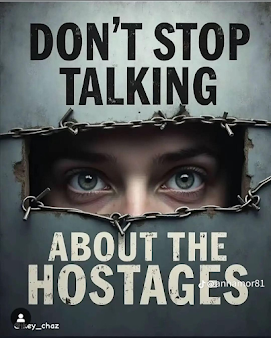
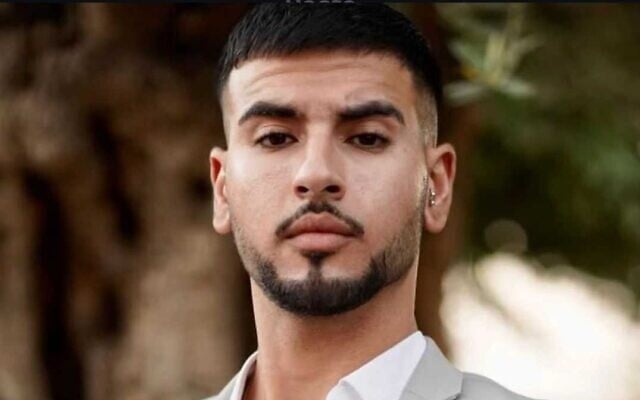








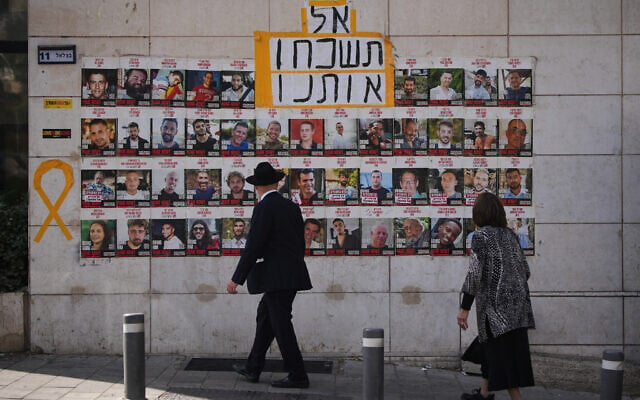
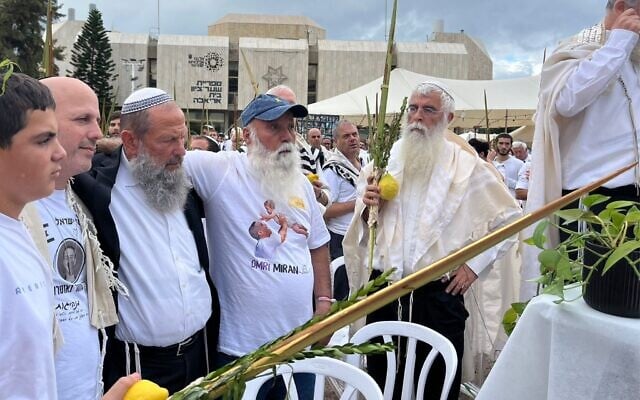




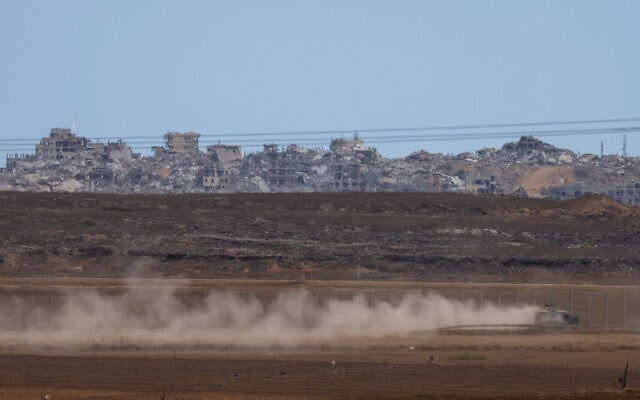
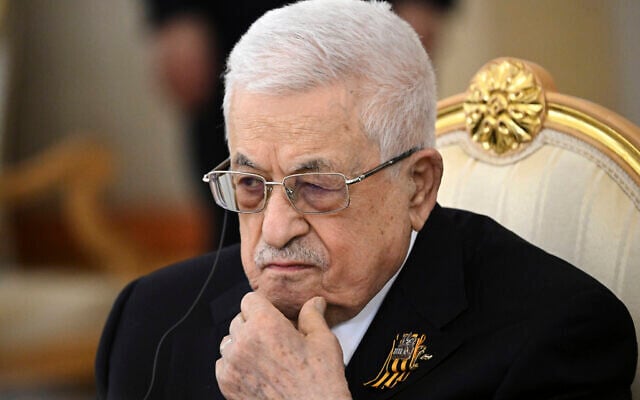
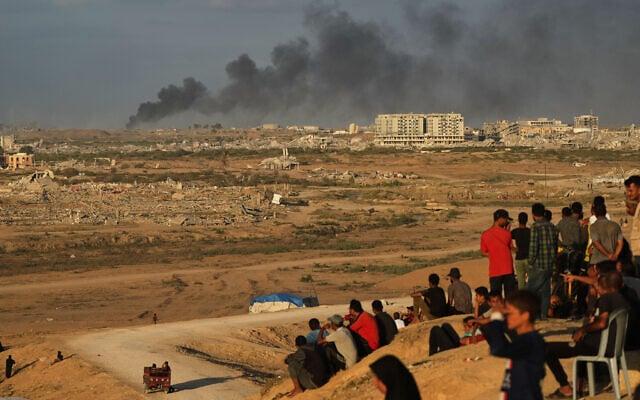
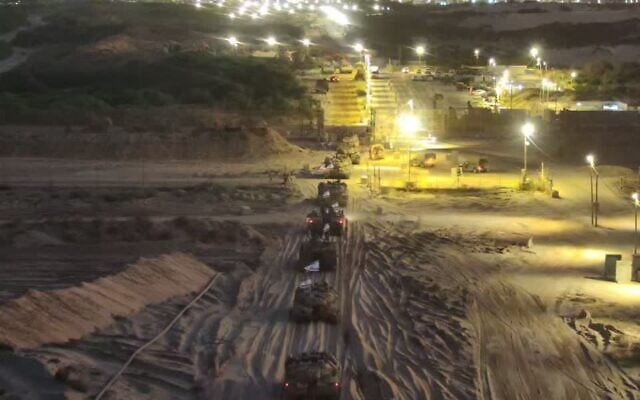
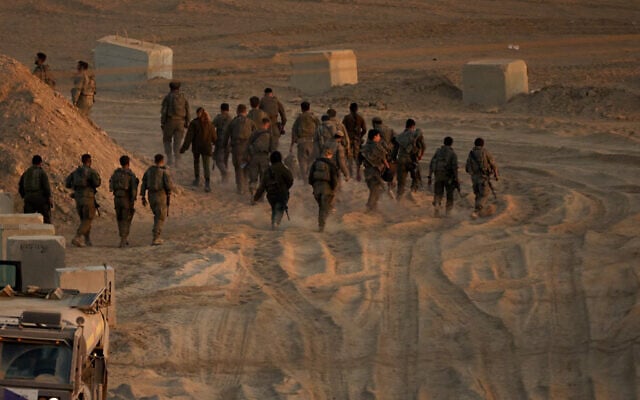
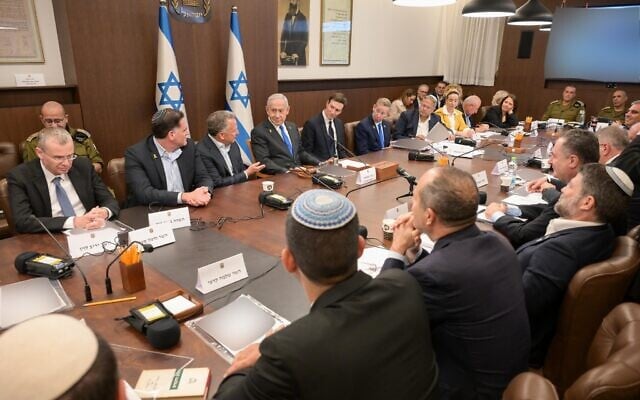



Comments
Post a Comment